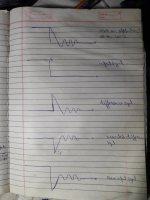If we take another coil of subwoofer to and use use it for negative feedback insead of loop from output of the amplifier . Will it be helpful for group delay desortion .
Thankyou for quick response . I will be doing this project . My subwoofer have lot of group delay at 30 to 80 hz . I think feedback will help .
There is a decaying signal after stoping the input sine wave i put in the amplifier . i think if i put that decaying signal back into the amplifier i can manage to cancel it out .
You don't need a feedback coil. There is a clever bridge arrangement that derives the feedback signal right at the amplifier output, another motional feedback method.
Also worth reading:
https://www.diyaudio.com/community/...hanical-parameters-by-electrical-means.64371/
Also worth reading:
https://www.diyaudio.com/community/...hanical-parameters-by-electrical-means.64371/
As jan.didden says, OP is asking about motional feedback. Yes, it has great benefits and there are quite a few ways to implement it, with ACE-Bass being just one popular method but there are similar designs that are easier to construct.
The attachment (I think I got it from Bolserst, a great guru on this forum) from 1958 explains just about everything anybody needs to know about MFB as a concept. I've been telling people about Werner's research since 1966.
Another approach is to have a voice coil winding dedicated to sensing cone motion and providing feedback. But it isn't feasible to take an ordinary dual-winding VC driver because the voltage produced is very tiny wired in this way. Sony and others have manufactured drivers with purpose-designed extra voice coils that have many more turns of fine wire to implement MFB.
B.
The attachment (I think I got it from Bolserst, a great guru on this forum) from 1958 explains just about everything anybody needs to know about MFB as a concept. I've been telling people about Werner's research since 1966.
Another approach is to have a voice coil winding dedicated to sensing cone motion and providing feedback. But it isn't feasible to take an ordinary dual-winding VC driver because the voltage produced is very tiny wired in this way. Sony and others have manufactured drivers with purpose-designed extra voice coils that have many more turns of fine wire to implement MFB.
B.
Attachments
Last edited:
Voice coil feedback has limited effect because it does only feedback voice coil movement, NOT cone movement. You still get all kinds of mechanical errors and breakup.
Even motional feedback from a motion sensor only feeds back the motion sensor motion which is not the same as the cone motion.
That limits the positive effects to a few 100 Hz at best.
Jan
Even motional feedback from a motion sensor only feeds back the motion sensor motion which is not the same as the cone motion.
That limits the positive effects to a few 100 Hz at best.
Jan
That emphasizes the limitations rather than the benefits of MFB. By that thinking, there's no good way to get the driver into a feedback loop. But the VC or dustcap motion represent a substantial part of all that comes out of the driver even if not perfect to every bit of cone flexing and sound from surrounds.
Also important is that the VC or dustcap are clear representations of group delay and that sort of driver behaviour called "tight" or "fast" that are the most valued benefits of MFB, in my opinion.
B.
Also important is that the VC or dustcap are clear representations of group delay and that sort of driver behaviour called "tight" or "fast" that are the most valued benefits of MFB, in my opinion.
B.
- Home
- Loudspeakers
- Subwoofers
- Negative feedback directly from subwoofer aka servo sub
